tow KIA Sorento 2007 1.G Owner's Manual
[x] Cancel search | Manufacturer: KIA, Model Year: 2007, Model line: Sorento, Model: KIA Sorento 2007 1.GPages: 325, PDF Size: 5.01 MB
Page 13 of 325
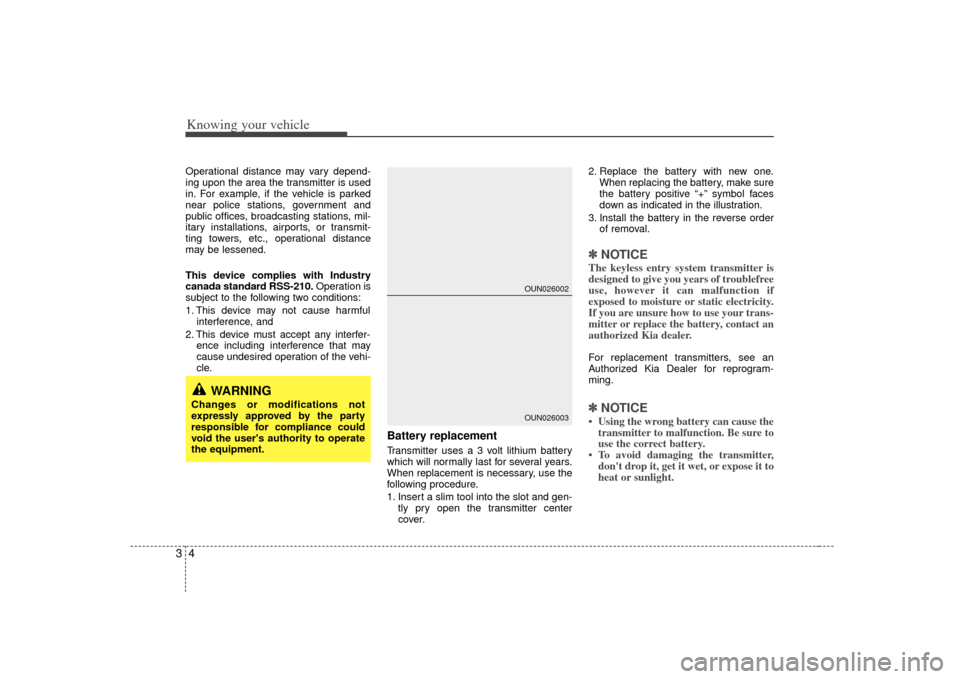
Knowing your vehicle43Operational distance may vary depend-
ing upon the area the transmitter is used
in. For example, if the vehicle is parked
near police stations, government and
public offices, broadcasting stations, mil-
itary installations, airports, or transmit-
ting towers, etc., operational distance
may be lessened.
This device complies with Industry
canada standard RSS-210.Operation is
subject to the following two conditions:
1. This device may not cause harmful interference, and
2. This device must accept any interfer- ence including interference that may
cause undesired operation of the vehi-
cle.
Battery replacementTransmitter uses a 3 volt lithium battery
which will normally last for several years.
When replacement is necessary, use the
following procedure.
1. Insert a slim tool into the slot and gen-tly pry open the transmitter center
cover. 2. Replace the battery with new one.
When replacing the battery, make sure
the battery positive “+” symbol faces
down as indicated in the illustration.
3. Install the battery in the reverse order of removal.
✽ ✽NOTICEThe keyless entry system transmitter is
designed to give you years of troublefree
use, however it can malfunction if
exposed to moisture or static electricity.
If you are unsure how to use your trans-
mitter or replace the battery, contact an
authorized Kia dealer. For replacement transmitters, see an
Authorized Kia Dealer for reprogram-
ming.✽ ✽NOTICE• Using the wrong battery can cause the
transmitter to malfunction. Be sure to
use the correct battery.
• To avoid damaging the transmitter, don't drop it, get it wet, or expose it to
heat or sunlight.
WARNING
Changes or modifications not
expressly approved by the party
responsible for compliance could
void the user's authority to operate
the equipment.
OUN026002OUN026003
Page 15 of 325
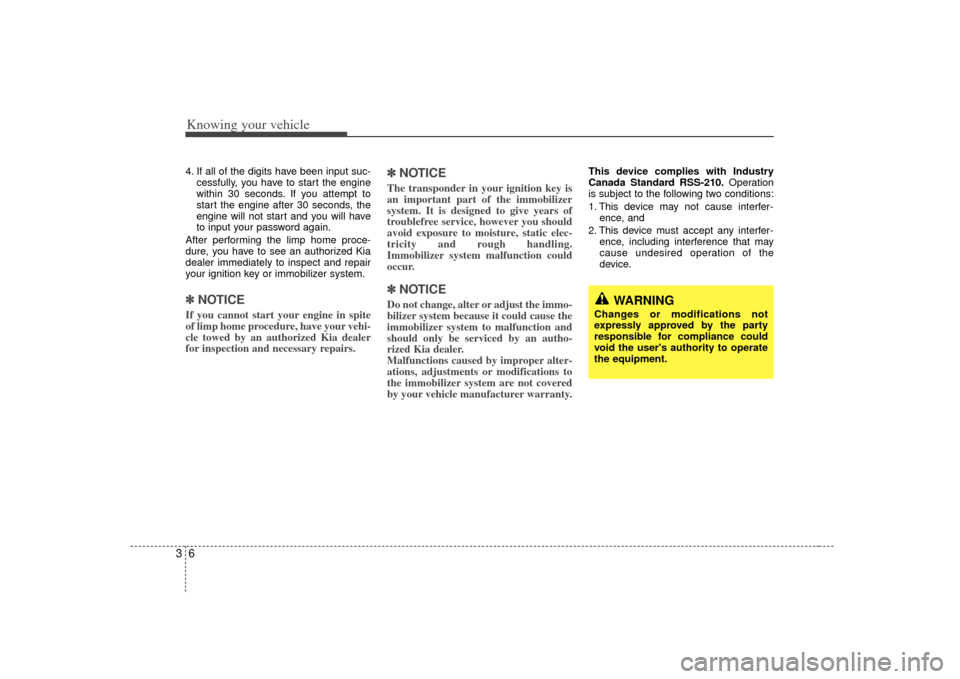
Knowing your vehicle634. If all of the digits have been input suc-cessfully, you have to start the engine
within 30 seconds. If you attempt to
start the engine after 30 seconds, the
engine will not start and you will have
to input your password again.
After performing the limp home proce-
dure, you have to see an authorized Kia
dealer immediately to inspect and repair
your ignition key or immobilizer system.✽ ✽ NOTICEIf you cannot start your engine in spite
of limp home procedure, have your vehi-
cle towed by an authorized Kia dealer
for inspection and necessary repairs.
✽ ✽NOTICEThe transponder in your ignition key is
an important part of the immobilizer
system. It is designed to give years of
troublefree service, however you should
avoid exposure to moisture, static elec-
tricity and rough handling.
Immobilizer system malfunction could
occur.✽ ✽NOTICEDo not change, alter or adjust the immo-
bilizer system because it could cause the
immobilizer system to malfunction and
should only be serviced by an autho-
rized Kia dealer.
Malfunctions caused by improper alter-
ations, adjustments or modifications to
the immobilizer system are not covered
by your vehicle manufacturer warranty.
This device complies with Industry
Canada Standard RSS-210. Operation
is subject to the following two conditions:
1. This device may not cause interfer- ence, and
2. This device must accept any interfer- ence, including interference that may
cause undesired operation of the
device.
WARNING
Changes or modifications not
expressly approved by the party
responsible for compliance could
void the user's authority to operate
the equipment.
Page 16 of 325
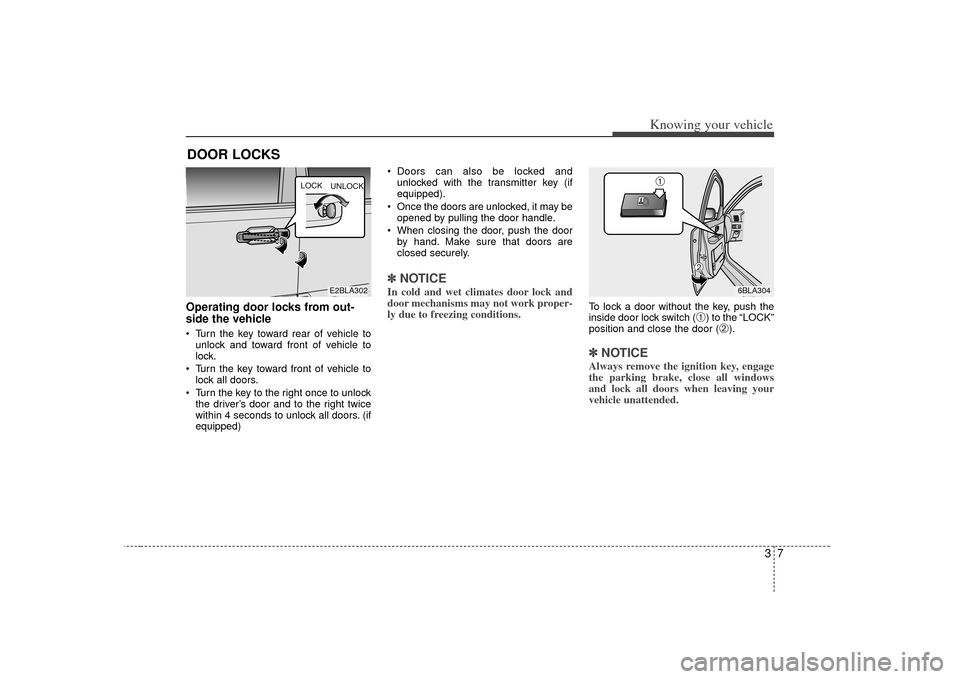
37
Knowing your vehicle
Operating door locks from out-
side the vehicle Turn the key toward rear of vehicle tounlock and toward front of vehicle to
lock.
Turn the key toward front of vehicle to lock all doors.
Turn the key to the right once to unlock the driver’s door and to the right twice
within 4 seconds to unlock all doors. (if
equipped) Doors can also be locked and
unlocked with the transmitter key (if
equipped).
Once the doors are unlocked, it may be opened by pulling the door handle.
When closing the door, push the door by hand. Make sure that doors are
closed securely.
✽ ✽ NOTICEIn cold and wet climates door lock and
door mechanisms may not work proper-
ly due to freezing conditions.
To lock a door without the key, push the
inside door lock switch (
➀) to the “LOCK”
position and close the door (
➁).
✽ ✽ NOTICEAlways remove the ignition key, engage
the parking brake, close all windows
and lock all doors when leaving your
vehicle unattended.
DOOR LOCKS
E2BLA302
LOCK
UNLOCK
6BLA304
➀
➁
Page 29 of 325
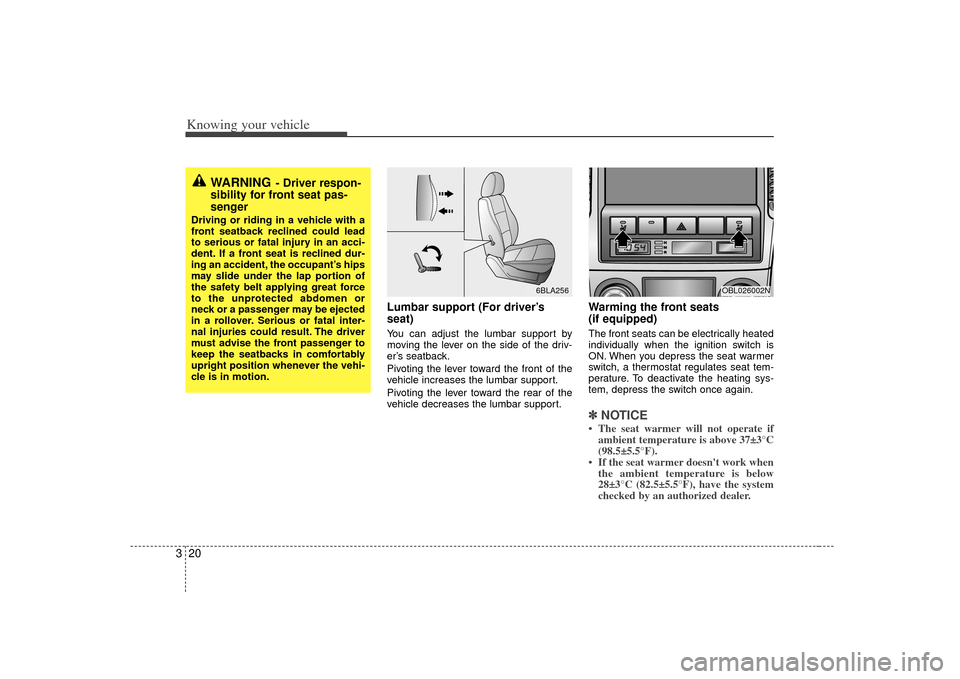
Knowing your vehicle20
3
Lumbar support (For driver’s
seat) You can adjust the lumbar support by
moving the lever on the side of the driv-
er’s seatback.
Pivoting the lever toward the front of the
vehicle increases the lumbar support.
Pivoting the lever toward the rear of the
vehicle decreases the lumbar support.
Warming the front seats
(if equipped)The front seats can be electrically heated
individually when the ignition switch is
ON. When you depress the seat warmer
switch, a thermostat regulates seat tem-
perature. To deactivate the heating sys-
tem, depress the switch once again.✽ ✽
NOTICE• The seat warmer will not operate if
ambient temperature is above 37±3°C
(98.5±5.5°F).
• If the seat warmer doesn't work when the ambient temperature is below
28±3°C (82.5±5.5°F), have the system
checked by an authorized dealer.
OBL026002N
WARNING
- Driver respon-
sibility for front seat pas-
senger
Driving or riding in a vehicle with a
front seatback reclined could lead
to serious or fatal injury in an acci-
dent. If a front seat is reclined dur-
ing an accident, the occupant’s hips
may slide under the lap portion of
the safety belt applying great force
to the unprotected abdomen or
neck or a passenger may be ejected
in a rollover. Serious or fatal inter-
nal injuries could result. The driver
must advise the front passenger to
keep the seatbacks in comfortably
upright position whenever the vehi-
cle is in motion.
6BLA256
Page 45 of 325
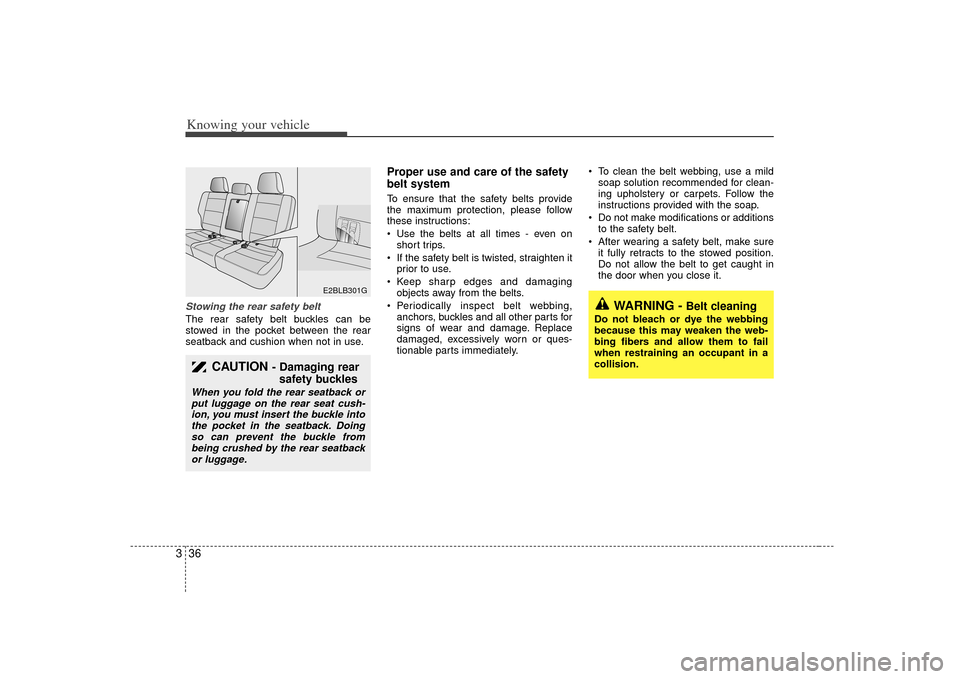
Knowing your vehicle36
3Stowing the rear safety belt The rear safety belt buckles can be
stowed in the pocket between the rear
seatback and cushion when not in use.
Proper use and care of the safety
belt system To ensure that the safety belts provide
the maximum protection, please follow
these instructions:
Use the belts at all times - even on
short trips.
If the safety belt is twisted, straighten it prior to use.
Keep sharp edges and damaging objects away from the belts.
Periodically inspect belt webbing, anchors, buckles and all other parts for
signs of wear and damage. Replace
damaged, excessively worn or ques-
tionable parts immediately. To clean the belt webbing, use a mild
soap solution recommended for clean-
ing upholstery or carpets. Follow the
instructions provided with the soap.
Do not make modifications or additions to the safety belt.
After wearing a safety belt, make sure it fully retracts to the stowed position.
Do not allow the belt to get caught in
the door when you close it.
WARNING -
Belt cleaning
Do not bleach or dye the webbing
because this may weaken the web-
bing fibers and allow them to fail
when restraining an occupant in a
collision.
E2BLB301G
CAUTION
- Damaging rearsafety buckles
When you fold the rear seatback or
put luggage on the rear seat cush-ion, you must insert the buckle into the pocket in the seatback. Doingso can prevent the buckle from being crushed by the rear seatbackor luggage.
Page 52 of 325
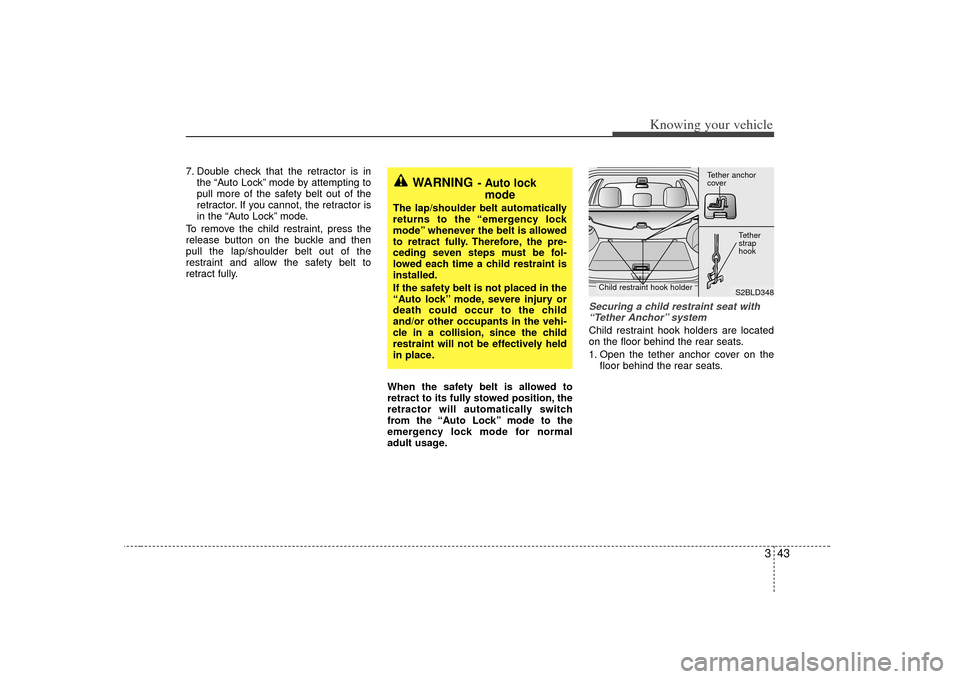
343
Knowing your vehicle
7. Double check that the retractor is inthe “Auto Lock” mode by attempting to
pull more of the safety belt out of the
retractor. If you cannot, the retractor is
in the “Auto Lock” mode.
To remove the child restraint, press the
release button on the buckle and then
pull the lap/shoulder belt out of the
restraint and allow the safety belt to
retract fully.
When the safety belt is allowed to
retract to its fully stowed position, the
retractor will automatically switch
from the “Auto Lock” mode to the
emergency lock mode for normal
adult usage.
Securing a child restraint seat with“Tether Anchor” system Child restraint hook holders are located
on the floor behind the rear seats.
1. Open the tether anchor cover on the floor behind the rear seats.
WARNING
- Auto lockmode
The lap/shoulder belt automatically
returns to the “emergency lock
mode” whenever the belt is allowed
to retract fully. Therefore, the pre-
ceding seven steps must be fol-
lowed each time a child restraint is
installed.
If the safety belt is not placed in the
“Auto lock” mode, severe injury or
death could occur to the child
and/or other occupants in the vehi-
cle in a collision, since the child
restraint will not be effectively held
in place.
S2BLD348
Tether anchor
coverTether
strap
hook
Child restraint hook holder
Page 58 of 325
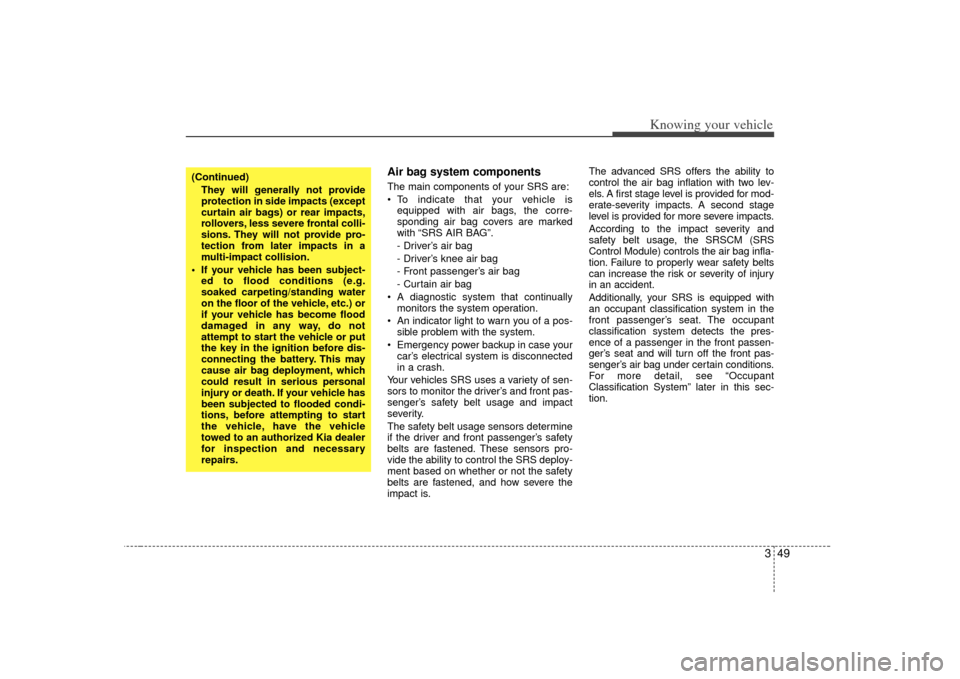
349
Knowing your vehicle
Air bag system components The main components of your SRS are:
To indicate that your vehicle isequipped with air bags, the corre-
sponding air bag covers are marked
with “SRS AIR BAG”.
- Driver’s air bag
- Driver’s knee air bag
- Front passenger’s air bag
- Curtain air bag
A diagnostic system that continually monitors the system operation.
An indicator light to warn you of a pos- sible problem with the system.
Emergency power backup in case your car’s electrical system is disconnected
in a crash.
Your vehicles SRS uses a variety of sen-
sors to monitor the driver’s and front pas-
senger’s safety belt usage and impact
severity.
The safety belt usage sensors determine
if the driver and front passenger’s safety
belts are fastened. These sensors pro-
vide the ability to control the SRS deploy-
ment based on whether or not the safety
belts are fastened, and how severe the
impact is. The advanced SRS offers the ability to
control the air bag inflation with two lev-
els. A first stage level is provided for mod-
erate-severity impacts. A second stage
level is provided for more severe impacts.
According to the impact severity and
safety belt usage, the SRSCM (SRS
Control Module) controls the air bag infla-
tion. Failure to properly wear safety belts
can increase the risk or severity of injury
in an accident.
Additionally, your SRS is equipped with
an occupant classification system in the
front passenger’s seat. The occupant
classification system detects the pres-
ence of a passenger in the front passen-
ger’s seat and will turn off the front pas-
senger’s air bag under certain conditions.
For more detail, see “Occupant
Classification System” later in this sec-
tion.
(Continued)
They will generally not provide
protection in side impacts (except
curtain air bags) or rear impacts,
rollovers, less severe frontal colli-
sions. They will not provide pro-
tection from later impacts in a
multi-impact collision.
If your vehicle has been subject- ed to flood conditions (e.g.
soaked carpeting/standing water
on the floor of the vehicle, etc.) or
if your vehicle has become flood
damaged in any way, do not
attempt to start the vehicle or put
the key in the ignition before dis-
connecting the battery. This may
cause air bag deployment, which
could result in serious personal
injury or death. If your vehicle has
been subjected to flooded condi-
tions, before attempting to start
the vehicle, have the vehicle
towed to an authorized Kia dealer
for inspection and necessary
repairs.
Page 61 of 325
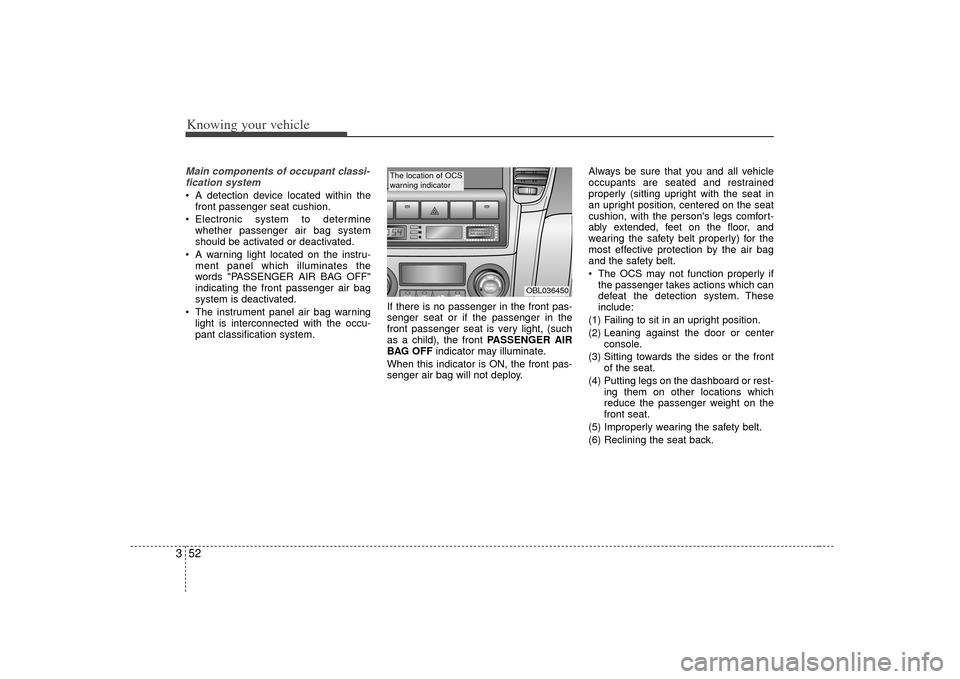
Knowing your vehicle52
3Main components of occupant classi-
fication system A detection device located within the front passenger seat cushion.
Electronic system to determine whether passenger air bag system
should be activated or deactivated.
A warning light located on the instru- ment panel which illuminates the
words "PASSENGER AIR BAG OFF"
indicating the front passenger air bag
system is deactivated.
The instrument panel air bag warning light is interconnected with the occu-
pant classification system. If there is no passenger in the front pas-
senger seat or if the passenger in the
front passenger seat is very light, (such
as a child), the front PASSENGER AIR
BAG OFF
indicator may illuminate.
When this indicator is ON, the front pas-
senger air bag will not deploy. Always be sure that you and all vehicle
occupants are seated and restrained
properly (sitting upright with the seat in
an upright position, centered on the seat
cushion, with the person's legs comfort-
ably extended, feet on the floor, and
wearing the safety belt properly) for the
most effective protection by the air bag
and the safety belt.
The OCS may not function properly if
the passenger takes actions which can
defeat the detection system. These
include:
(1) Failing to sit in an upright position.
(2) Leaning against the door or center console.
(3) Sitting towards the sides or the front of the seat.
(4) Putting legs on the dashboard or rest- ing them on other locations which
reduce the passenger weight on the
front seat.
(5) Improperly wearing the safety belt.
(6) Reclining the seat back.
OBL036450
The location of OCS
warning indicator
Page 64 of 325

355
Knowing your vehicle
(Continued)
If a very low weight adult is seat-ed in the front passenger seat, the
occupant classification system
may or may not turn off the right
front passenger air bag, depend-
ing upon the person's seating
position and body type. Everyone
in your vehicle should wear a
safety belt properly -- whether or
not there is an air bag for that per-
son.
If the front seat passenger changes their seating position
(for example, by not sitting
upright, by sitting on the edge of
the seat, or by otherwise being
out of position), the "PASSEN-
GER AIR BAG OFF" indicator may
be turned on, and the passenger
air bag may not deploy in a colli-
sion. Always be sure to sit prop-
erly in the front passenger seat
and wear the safety belt properly.
(Continued)
(Continued)
(Continued)
(Continued)
(Continued)
1KMN36611KMN3662
- Never put a heavy load in thefront passenger seat.
- Never excessively recline the front passenger seatback.
1KMN36631KMN3664
- Never sit with hips shiftedtowards the front of the seat.
- Never lean on the center con- sole.
- Never sit on one side of the front passenger seat.
Page 84 of 325
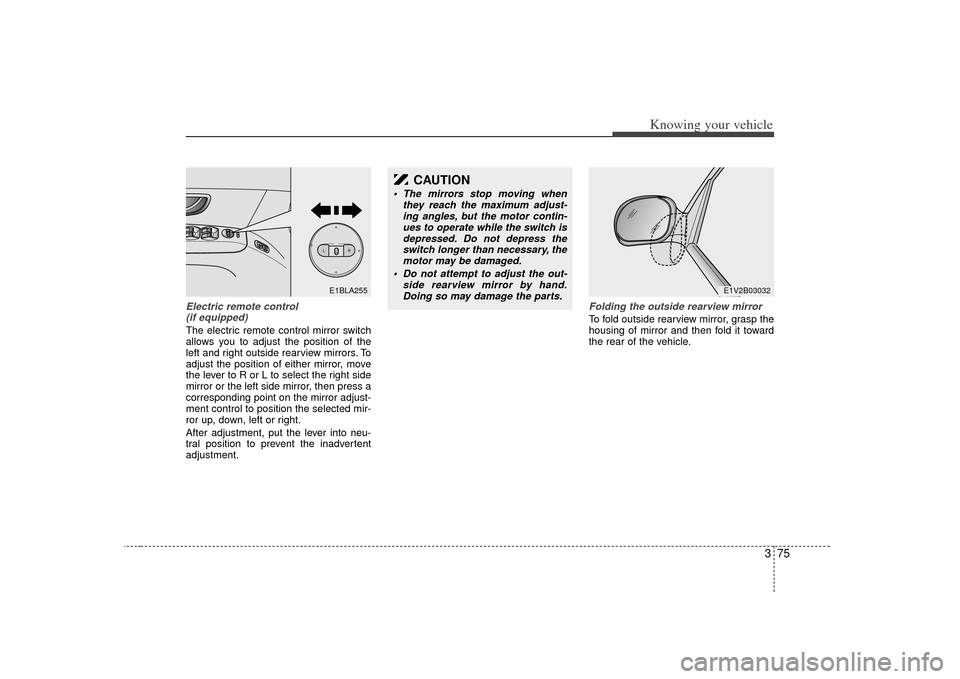
375
Knowing your vehicle
Electric remote control (if equipped)The electric remote control mirror switch
allows you to adjust the position of the
left and right outside rearview mirrors. To
adjust the position of either mirror, move
the lever to R or L to select the right side
mirror or the left side mirror, then press a
corresponding point on the mirror adjust-
ment control to position the selected mir-
ror up, down, left or right.
After adjustment, put the lever into neu-
tral position to prevent the inadvertent
adjustment.
Folding the outside rearview mirrorTo fold outside rearview mirror, grasp the
housing of mirror and then fold it toward
the rear of the vehicle.
LRE1BLA255
CAUTION
The mirrors stop moving when they reach the maximum adjust-ing angles, but the motor contin-ues to operate while the switch is depressed. Do not depress theswitch longer than necessary, themotor may be damaged.
Do not attempt to adjust the out- side rearview mirror by hand.Doing so may damage the parts.
E1V2B03032